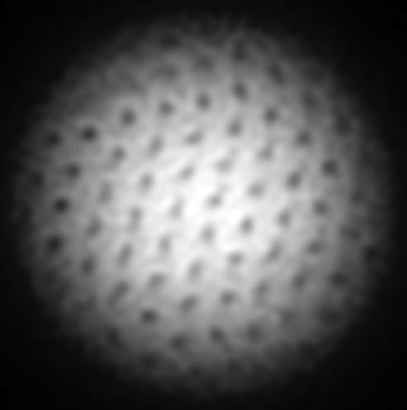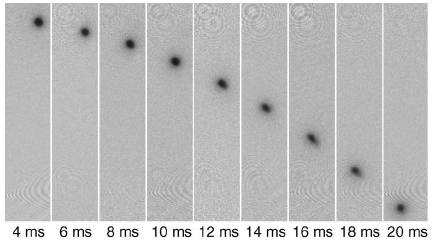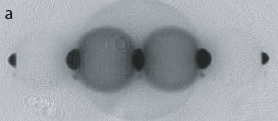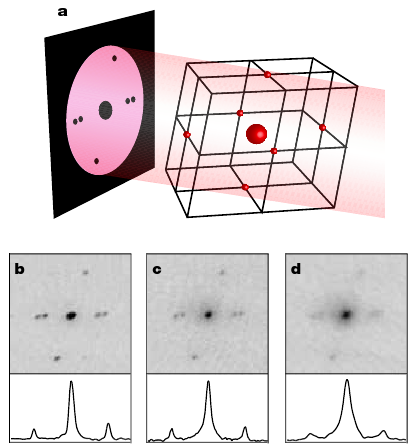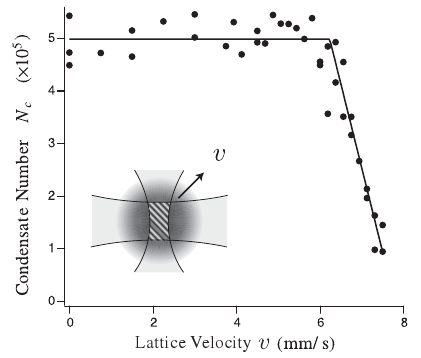Our machine has produced some remarkable results in its twelve-year long history. Here we give a brief overview of some of the highlights, in chronological order.
Vortex arrays
Quantized vortices play a key role in superfluidity and superconductivity. The formation of highly ordered vortex lattices in a rotating Bose-condensed gas was observed here. These triangular lattices contained over 100 vortices with lifetimes of several seconds. Individual vortices persisted up to 40 seconds. The lattices could be generated over a wide range of rotation frequencies and trap geometries, shedding light on the formation process.
Science 292, 476 (2001)
Macroscopic pair-correlated atomic beams
By colliding two Bose-Einstein condensates we have observed strong bosonic stimulation of the elastic scattering process. When a weak input beam (third wave) was applied as a seed, it was amplified by a factor of 20, and an initially unpopulated conjugate wave was created. This large gain atomic four-wave mixing resulted in the generation of two macroscopically occupied pair-correlated atomic beams. Since each collision process adds one atom each to the seed and conjugate waves, fluctuations in the relative atom number are suppressed (squeezed). For the observed gain of twenty, the number fluctuations should be below the shot noise by a factor of 40^1/2^. We have also identified some limitations for using collisions to create twin beams, including loss by subsequent collisions, and competition between other modes with similar gain.
High-gain four wave mixing of matter waves. The wavepackets separated during 43 ms of ballistic expansion. (a) Only a 1% seed was present (barely visible), (b) only two source waves were created and no seed, (c) two source waves and the seed underwent the four-wave mixing process where the seed wave and the fourth wave grew to a size comparable to the source waves. The crosses mark the center position of the unperturbed condensate. The field of view is 1.8 mm wide.
PRL 89, 020401 (2002)
Formation of quantum-degenerate Sodium molecules
In 2003, several groups succeeded in converting ultracold atoms into ultracold molecules by magnetically tuning a molecular level close to zero binding energy (Feshbach resonance). Atoms can then form molecules without release of heat. Our experiment was the first to produce a molecular cloud clearly in the quantum-degerenate regime. Ultracold sodium molecules were created from an atomic Bose-Einstein condensate by ramping an applied magnetic field across a Feshbach resonance. More than 10^5^ molecules were generated with a conversion efficiency of ~4%. High phase-space density could only be achieved by rapidly removing residual atoms, before atom-molecule collisions caused trap loss and heating. This was accomplished by a new technique for preparing pure molecular clouds, where light resonant with an atomic transition selectively ''blasted'' unpaired atoms from the trap. Time-of-flight analysis of the pure molecular sample yielded an instantaneous phase-space density greater than 20.
Ballistic expansion of a pure molecular sample. Absorption images of molecular clouds (after reconversion to atoms) are shown for increasing expansion time after switching off the optical trap. The small expansion velocity corresponds to a temperature of about 30 nK, characteristic of high phase-space density. The images are taken along the weak axis of the trap. The field of view of each image is 3.0 mm x 0.7 mm.
PRL 91, 210402 (2003)
Coherent molecular optics
Coherent molecular optics was performed using two-photon Bragg scattering. Molecules were produced by sweeping an atomic Bose-Einstein condensate through a Feshbach resonance. The spectral width of the molecular Bragg resonance corresponded to an instantaneous temperature of 20 nK, indicating that atomic coherence was transferred directly to the molecules. An autocorrelating interference technique was used to observe the quadratic spatial dependence of the phase of an expanding molecular cloud. Finally, atoms initially prepared in two momentum states were observed to cross pair with one another, forming molecules in a third momentum state. This process is analogous to sum-frequency generation in optics.
PRL 94, 040405 (2005)
Fermionic superfluidity
Superfluidity of a fermionic gas in an optical lattice was shown for the first time. The diffraction peaks observed after releasing the Fermi mixture from the lattice is characteristic for a superfluid. It was also shown that in a deeper lattice superfluidity is lost in a reversible way.
Nature 443, 961 (2006)
Critical velocity
The critical velocity of a superfluid mixture of the lowest two spin states of Lithium-6 was measured by moving a lattice at constant speed through the atom cloud. When the lattice velocity exceeds the critical velocity, dissipation kicks in and an atom loss can be measured.
PRL 99, 070402 (2007)
